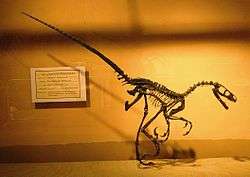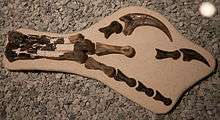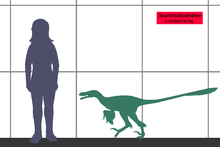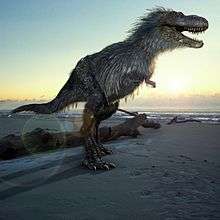Saurornitholestes
| Saurornitholestes Temporal range: Late Cretaceous, 77–69 Ma | |
|---|---|
 | |
| Mounted skeleton, Museum of the Rockies | |
| Scientific classification | |
| Kingdom: | Animalia |
| Phylum: | Chordata |
| Class: | Reptilia |
| Clade: | Dinosauria |
| Order: | Saurischia |
| Suborder: | Theropoda |
| Family: | †Dromaeosauridae |
| Clade: | †Eudromaeosauria |
| Genus: | †Saurornitholestes Sues, 1978 |
| Type species | |
| †Saurornitholestes langstoni Sues, 1978 | |
| Species | |
| |
| Synonyms | |
| |
Saurornitholestes ("lizard-bird thief") is a genus of carnivorous dromaeosaurid theropod dinosaur from the late Cretaceous of Alberta, Montana and New Mexico.
Two species have been named: Saurornitholestes langstoni in 1978 and Saurornitholestes sullivani in 2015. Saurornitholestes was a small bipedal meat-eating dinosaur, equipped with a sickle-claw on the foot.
Discovery and naming

In 1974 Canadian amateur paleontologist Irene Vanderloh discovered the skeleton of a small theropod near Steveville in Alberta . She showed it to John Storer of the Provincial Museum of Alberta, who brought it to the attention of Hans-Dieter Sues. In 1978 Sues named and described the specimen as the type species Saurornitholestes langstoni. The generic name is in reference to the Saurornithoididae, due to the resemblance with this group that is today seen as part of the Troodontidae, and combines their name with a Greek lestes, "thief". The specific name honours Wann Langston, Jr.
The holotype specimen, RTMP 74.10.5, was uncovered in a layer of the Dinosaur Park Formation dating to the late Campanian. It consists of a very fragmentary skeleton including teeth, skull elements, two vertebrae, ribs, tail elements and a hand. Also three paratypes were assigned: CMN 12343, CMN 12354, and UA 5283, all frontals.[1]
Two more complete and larger partial skeletons (RTMP 88.121.39 and MOR 660), dozens of isolated bones, and scores of teeth are today known from the badlands of Dinosaur Provincial Park in Alberta; most of these are housed at the Royal Tyrrell Museum of Palaeontology, in Drumheller, Alberta and remain undescribed. The Alberta and Montana remains are usually attributed to the single species Saurornitholestes langstoni, though they come from a variety of rock formations indicating a wide span of time; for example, the Oldman Formation (dated to about 77 million years ago[2]) and the upper Two Medicine Formation (about 72 million years ago). Similar teeth are found in younger deposits, dated to around 70 to 69 million years ago,[3] but whether they represent S. langstoni or a different, related species is unknown. Neonate-sized Saurornitholestes fossils have been reported in the scientific literature.[4]
Saurornitholestes sullivani is known from the Hunter Wash fauna of the Kirtland Formation in New Mexico, based on the frontal SMP VP-1270. It differs from S. langstoni in the characters of the frontal.[5]
Misassigned species
In 2006 Robert Sullivan named and described a second nominal species, Saurornitholestes robustus, based on holotype SMP VP-1955, a left frontal. The specific name refers to the great thickness of this bone, the only trait in which the species is known to differ from S. langstoni. The holotype was found in the Willow Wash fauna of the Kirtland Formation in New Mexico, dated to about 73 million years ago.[6] However, a subsequent overview of dromaeosaurid phylogeny asserted that S. robustus lacked dromaeosaurid characters and should be considered an indeterminate theropod,[7] and a study published in 2014 took the conclusion a step further by demonstrating that S. robustus was assignable to Troodontidae based on similarities with troodontids.[8]
Possible indeterminate fossils are known from the Hell Creek Formation in Montana, North Dakota, and South Dakota, dated to about 66 million years ago.[9]
Description

Like other theropods in the Dromaeosauridae, Saurornitholestes had a long, curving, blade-like claw on the second toe. Saurornitholestes was more long-legged and lightly built than other dromaeosaurids such as Velociraptor and Dromaeosaurus. It resembles Velociraptor in having large, fanglike teeth in the front of the jaws. Saurornitholestes most closely resembles Velociraptor, although the precise relationships of the Dromaeosauridae are still relatively poorly understood.
Saurornitholestes was about 1.8 m (5.9 ft) long[10] and weighed approximately 10 kg (22 lb).[11] At the hip it stood 0.6 meters (2 feet), or around as tall as the length of a terrier.
Saurornitholestes sullivani is thought to have had a keen sense of smell, due to its skull suggesting an unusually large olfactory bulb.[12]
Phylogeny
In 1978 Sues assigned Saurornitholestes to the Dromaeosauridae. Later studies most often found it a member of the dromaeosaurid Velociraptorinae, but a cladistic analysis by Philip J. Currie in 2009 recovered a position in a more basal dromaeosaurid clade that was named the Saurornitholestinae.
The cladogram below follows a 2015 analysis by paleontologists Robert DePalma, David Burnham, Larry Martin, Peter Larson, and Robert Bakker, using updated data from the Theropod Working Group.[13]
| Dromaeosauridae |
| ||||||||||||||||||||||||||||||||||||||||||||||||||||||||||||||||||||||||||||||
| |
Paleobiology
Habitat

Alberta, the location of Saurornitholestes langstoni, had a habitat similar to the United States Middle West being plains[14] and floodplain swamps.[15]
Saurornitholestes appears to have been the most common small theropod in Dinosaur Provincial Park, and teeth and bones are much more common than those of its more massive contemporary, Dromaeosaurus. Little is known about what it ate and how it lived, but a tooth of Saurornitholestes has been found embedded in the wing bone of a large pterosaur, probably a juvenile Quetzalcoatlus.[16] Because the pterosaur was so much larger than Saurornitholestes, Currie and Jacobsen suggest that the theropod was probably scavenging the remains of an already dead animal.[16]
Bite marks from tyrannosaur

Aase Roland Jacobsen published a description of a Saurornitholestes dentary in 2001.[17] The dentary is about 12 cm long and preserves fifteen tooth positions, of which only ten preserve teeth.[18] Three toothmarks were visible on the inner "lingual" surface of the dentary.[18] Two of the three marks are series of grooves made by the serrations on the maker's teeth.[18] The striations are between .37 mm and .40 mm thick with cuboidal cross-sections.[19]
The shape of the preserved serrations are too different from those of Saurornitholestes for the marks to be the result of injuries incurred during intraspecific face biting behaviors.[20] Although the right shape for Dromaeosaurus tooth serrations, the preserved marks are too coarse to have been left by that genus.[20] Although a specific identification cannot be made, the most likely perpetrator would be a juvenile individual of one of the Dinosaur Park Formation's tyrannosaurids, like Gorgosaurus, or Daspletosaurus.[21]
Stress fractures
In 2001, Bruce Rothschild and others published a study examining evidence for stress fractures and tendon avulsions in theropod dinosaurs and the implications for their behavior. They found that only two of the 82 Saurornitholestes foot bones checked for stress fractures actually had them. Two of the nine hand bones examined for stress fractures were found to have them.[22]
See also
Footnotes
- ↑ H.-D. Sues, 1978, "A new small theropod dinosaur from the Judith River Formation (Campanian) of Alberta Canada", Zoological Journal of the Linnean Society 62: 381-400
- ↑ Arbour, et al. (2009).
- ↑ "3.33 Alaska, United States; 3. Prince Creek Formation," in Weishampel et al. (2004). Page 587.
- ↑ "Abstract," Tanke and Brett-Surman (2001). Page 207.
- ↑ Steven E. Jasinski (2015) A new dromaeosaurid (Theropoda: Dromaeosauridae) from the Late Cretaceous of New Mexico. in Sullivan, R.M. and Lucas, S.G., eds. Fossil Record 4. New Mexico Museum of Natural History and Science Bulletin 67: 79-88
- ↑ Sullivan and Lucas (2006).
- ↑ Turner, A.H., Makovicky, P.J. and Norell, M.A., 2012, A review of dromaeosaurid systematics and paravian phylogeny: Bulletin of the American Museum of Natural History, v. 371, p. 1–206.
- ↑ Evans, D.C., Larson, D.W., Cullen, T.M. and Sullivan, R.M., 2014. "Saurornitholestes" robustus is a troodontid (Dinosauria: Theropoda): Canadian Journal of Earth Sciences, v. 51, p. 730–734.
- ↑ Dinosaur distribution (Late Cretaceous; North America; North Dakota). Weishampel, et al. (2004). Page 585
- ↑ Currie and Koppelhus (2005). Pages 372-373.
- ↑ Longrich and Currie (2009).
- ↑ "http://www.sciencedaily.com/releases/2015/05/150511125312.htm". www.sciencedaily.com. Retrieved 2015-06-05. External link in
|title=(help) - ↑ DePalma, Robert A.; Burnham, David A.; Martin, Larry D.; Larson, Peter L.; Bakker, Robert T. (2015). "The First Giant Raptor (Theropoda: Dromaeosauridae) from the Hell Creek Formation.". Paleontological Contributions (14).
- ↑ About: Saurornitholestes
- ↑ Norell and Makovicky.
- 1 2 Currie and Jacobsen (1995).
- ↑ "Abstract," Jacobsen (2001). Page 58.
- 1 2 3 "Description," Jacobsen (2001). Page 59.
- ↑ "Description," Jacobsen (2001). Page 60.
- 1 2 "Discussion," Jacobsen (2001). Page 60.
- ↑ "Discussion," Jacobsen (2001). Page 61.
- ↑ "Table 23.1," in Rothschild, et al. (2001); page 333.
References
- Arbour, V. M.; Burns, M. E.; Sissons, R. L. (2009). "A redescription of the ankylosaurid dinosaur Dyoplosaurus acutosquameus Parks, 1924 (Ornithischia: Ankylosauria) and a revision of the genus". Journal of Vertebrate Paleontology. 29 (4): 1117–1135. doi:10.1671/039.029.0405.
- Currie, Philip J.; Jacobsen, Aase Roland (1995). "An azhdarchid pterosaur eaten by a velociraptorine theropod" (PDF). Canadian Journal of Earth Sciences. 32 (7): 922–925. doi:10.1139/e95-077.
- Currie P.J. & Koppelhus E.B., Dinosaur Provincial Park: a spectacular ancient ecosystem revealed, Vol. 1 (Indiana University Press, 2005), p. 372-373.
- Jacobsen, A.R. 2001. Tooth-marked small theropod bone: An extremely rare trace. p. 58-63. In: Mesozoic Vertebrate Life. Ed.s Tanke, D. H., Carpenter, K., Skrepnick, M. W. Indiana University Press.
- Longrich N.R. & Currie P.J. (2009), "A microraptorine (Dinosauria–Dromaeosauridae) from the Late Cretaceous of North America", PNAS 106(13): p. 5002-5007.
- Norell, Mark A. and Makovicky, Peter J. "Dromaeosauridae." In: Weishampel, David B.; Dodson, Peter; and Osmólska, Halszka (eds.): The Dinosauria, 2nd, Berkeley: University of California Press. Pp. 208. ISBN 0-520-24209-2
- Saurornitholestes - Dinosaur Saurornitholestes Characteristics, Behavior and Habitat; Subheadings: Habitat, Historical Period, Size and Weight
- Sullivan, R.M. (2006). "Saurornitholestes robustus, n. sp. (Theropoda:Dromaeosauridae) from the Upper Cretaceous Kirtland Formation (De-Na-Zin member_), San Juan Basin, New Mexico." NMMNH Bulletin 35: 253-256.
- Sullivan, R.M. and Lucas, S.G. (2006). "The Kirtlandian land-vertebrate "age" – faunal composition, temporal position and biostratigraphic correlation in the nonmarine Upper Cretaceous of western North America." New Mexico Museum of Natural History and Science, 35: 7-29.
- Tanke, D.H. and Brett-Surman, M.K. 2001. Evidence of Hatchling and Nestling-Size Hadrosaurs (Reptilia:Ornithischia) from Dinosaur Provincial Park (Dinosaur Park Formation: Campanian), Alberta, Canada. pp. 206–218. In: Mesozoic Vertebrate Life—New Research Inspired by the Paleontology of Philip J. Currie. Edited by D.H. Tanke and K. Carpenter. Indiana University Press: Bloomington. xviii + 577 pp.

